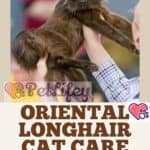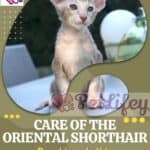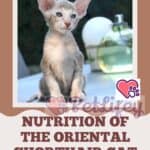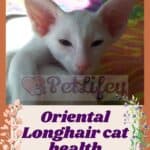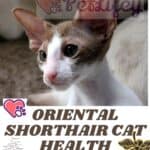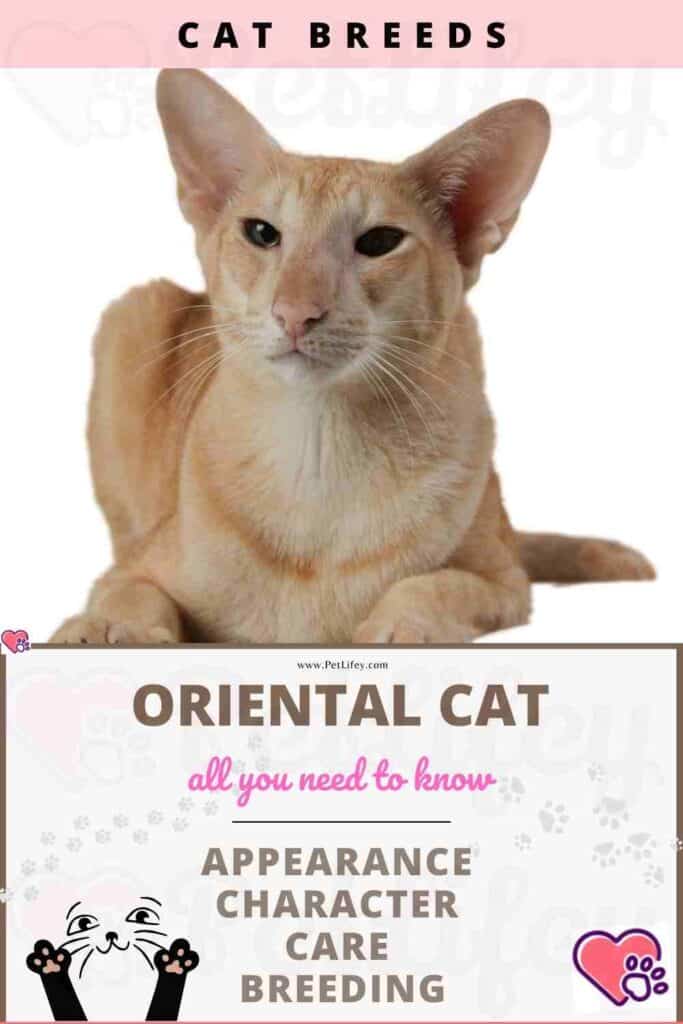
The Oriental cat is a cat with a very elegant fluid line, very agile, lively and sensitive, to the point of having been compared several times to Greyhounds.
It has three very important characteristics: the first is that it is much more attached to its master than to the house where he lives, because it understands very well that it is from its master that it obtains affection, shelter and food, but its great dignity prevents them from becoming dependent.
The second is its entrenched conviction that man is its fellow man; it therefore requires an egalitarian relationship in a reciprocal exchange of respect, esteem and affection.
The third is due to the fact that the Oriental expresses itself by making vocalizations; its vocabulary is really very extensive, we can say that it has sounds and combinations of sounds for all occasions, so that it manages to lead real conversations, but it can also exaggerate and become boring, even irritating .
The origins of the Oriental Cat
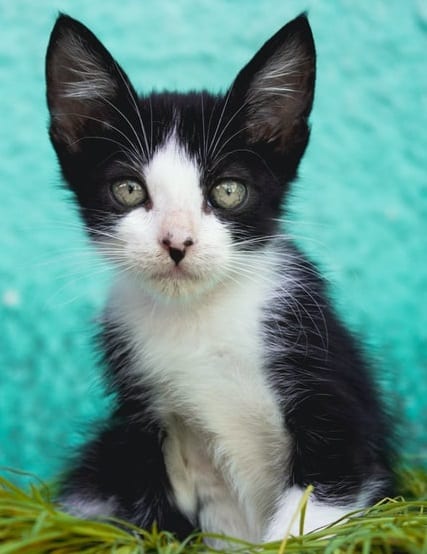
Siam, present-day Thailand, is the birthplace of the Oriental cat .
It is indeed among the ruins of Ayuthia, the ancient capital, that we found not only representations of cats very close to him, but also a manuscript, the Poem of the cat, in which there are illustrations representing felines with brown, blue, white and silver coats, which have a lot in common with the modern race.
A study carried out in recent years on Thai breeds found that, although they all have the same morphology, about half are solid in color or two-tone with green eyes, while only a small part, about 15 to 20% , is colour pointed.
Obviously, this minority had much more success with Westerners since, while the Siamese were imported in 1884 and quickly recognized as a breed, it was not until the fifties that some English breeders began to reconstruct this “new” Oriental breed, officially recognized in 1976-1977 and now widespread throughout the world.
Appearance of the Oriental Cat
The structure of the Oriental cat is medium and elongated, but above all elegant, endowed with a fine bone structure and good muscle tone. The long triangular head is of medium proportions to the body and has a straight profile and a flat skull.
The muzzle is thin and in a triangle, the strong chin forms a vertical line with the nose which is long and continuously extends the line of the forehead.
The slightly elongated almond eyes are medium in size, sloping towards the center of the base of the ear and bright in color and preferably green. The ears are incredibly large, very open at the base to extend the triangle of the head, and pointy.
The tubular body has the same width at the shoulders and hips and does not show any trace of fat. The legs are long and thin, with a fine but muscular bone structure; the hind legs are a little longer than the front ones, the feet are small and oval.
The tail is very long and thin, even at the base, from which it becomes thinner and thinner until it becomes extremely thin at the tip. The coat is very short, the coat is smooth and shiny, and flat; the texture is fine.
Coat color of the Oriental Cat
For Orientals, all colors are allowed, whether uniform or tabby, excluding colourpointed dresses.
The character of the Oriental Cat
Its physical aspect, skinny and harmonious, contrasts with its “angular” character, that is to say very strong and determined which often leads to stubbornness; it only lets themselves be dominated by those whom it thinks can.
Proud and sometimes sensitive, it does not accept relationships of dependence even if he is very attached to its master; it is totally devoted to the latter and he is terribly possessive towards them, but always seeks its affection and attentions.
It has a cheerful and sociable nature that it most often exteriorizes through incessant chatter, proof of its great intelligence; many people, because of its great vivacity and qualities described above, esteem and adore them, while others think that it is too boisterous.
Hug:
Hugs? But of course! This cat will be happy to receive a little tenderness and the sweetness of your caresses. It will undoubtedly come to curl up on you to ask you for more!
Player:
It is a very active cat who needs a lot of movement. Daily play periods are, without a shadow of a doubt, essential for them, as are mental work sessions, such as training them to give a paw or fetch its toy.
Calm:
It has barely stopped when it’s already left! You can easily be overwhelmed by its fiery and high energy.
Intelligent:
Without question, this is a cat with intelligence. With such a level of activity, it can only find themselves in situations where it will have to show ingenuity to achieve its ends. It will surprise you with its resourcefulness and presence of mind.
Fearful / Suspicious of Strangers:
As with other cats, the socialization period is very important for this breed. The cat should meet as many people as possible during this period in order to avoid developing fear of strangers.
Independent:
It is a cat that could be qualified as an applicant. It will tolerate your absences without flinching, but when you get back, you will need to make sure you have time to offer them, otherwise it may get bored and find things to do to take care of that you do not like. maybe not !
Behavior of the Oriental Cat
Talkative:
As with the rest of the large oriental family, its vocal repertoire is very developed and it often uses it excessively. Sensitive ears refrain!
Greedy / gluttonous:
This cat needs an adequate caloric intake to meet its energy expenditure, but you still have to watch the amount of food it ingests. It can eventually become greedy if you aim for the portions you serve them.
Need for exercise:
This cat has a great need to move. It will be necessary to plan daily activity sessions for its physical and mental well-being.
Runaway:
Vigilance is essential with this breed as with other very energetic breeds. It’s a safe bet that a bird or an insect that passes in front of an open window will be irresistible to them and drag them into unexplored territories.
Compatibility of the Oriental Cat with other animals
The Oriental and the Dogs:
The expression “The two go hand in hand!” Applies very well to the dog-Oriental tandem with respectful and gentle presentations, which allow the cat to go at its own pace.
Oriental and Other Cats:
With a proper introduction, this cat can very well live in a house in the presence of a congener.
The Oriental and the Children:
It is quite possible that the child-Oriental duo is one of hell! A relationship based on respect between the cat and the child will be lasting and will bring hours of fun and playfulness between the two friends!
The Oriental and the Elderly:
A calm person might find it difficult to deal with such an active and vocal cat.
Price of the Oriental Cat
On average, the purchase price of an Oriental kitten in breeding is between 600 USD and 3500 USD, the price often varying according to the line, the breeding, the age or even the sex, but also according to the coat length (the Javanese or Mandarin is not the same price as the Oriental Shorthair).
For the monthly budget, it will take an average of 50 USD/ month to meet the needs of this cat, by offering them a quality diet and making sure to keep them in good health.
Maintenance of the Oriental Cat
Grooming:
This breed requires minimal maintenance. For both varieties, weekly brushing is sufficient. For the Javanese or Mandarin, a comb is the tool of choice.
Hair loss:
Both varieties (short and semi-long hair) shed very little. It should be noted, however, that during the moulting period, the hair loss may be more important and more frequent brushing may become necessary.
Food of the Oriental Cat
Consult with your veterinary team to determine the best food to offer your cat to meet her high energy needs.
Caring for the Oriental Cat
The Oriental cat is a healthy cat but its very short hair makes it a little chilly. Grooming is practically superfluous, insofar as a caress is enough in addition to the maintenance of the environment in which the cat lives; It is only for special occasions that one will use the glove, in velvet, wool or felt.
Health of the Oriental Cat
Life
expectancy : The life expectancy of this breed is between 10 and 20 years, with an average around 15 years.
Resilient / Hardy:
Whether it is the short-haired or long-haired variety, this cat does not hold up well in cold temperatures. The lack of undercoat in the long-haired variety explains why this cat is cautious.
Tendency to put on weight:
In general, this cat eliminates the calories ingested without problem since it is very active and it expends a lot. Your veterinarian team will be able to calculate for you the portions of food to serve each day so that your cat maintains a healthy weight.
Frequent illnesses:
The Oriental is predisposed to the same illnesses as its cousin:
Renal amyloidosis: also hereditary, this disease is fortunately quite rare, but the outcome is always fatal. Progression is rapid when the disease occurs and symptoms usually appear between the ages of 1 and 5 years. They are very similar to the symptoms of kidney failure which would be quite severe . No screening test is currently available, because the genetics behind the disease are unclear.
Some individuals can suffer from the same diseases as other domestic cats, such as oral diseases .
- Progressive retinal atrophy : an inherited disease that causes blindness in the short to medium term. In some cases, the disease can start late in the cat’s life, giving it the opportunity to gradually adjust to its condition. Unfortunately, when she declares herself very young, the kitten quickly becomes blind and has little time to get used to it.
Reproduction:
Marriages are allowed with the Siamese , the Balinese (long-haired Siamese) and the Javanese .
Good to know
Did you know that Havana Brown comes from the Oriental? Her brown coat is one of the colors that appeared after many crosses made in the 1950s. The Havana entered the United States earlier than its cousin and evolved into a full breed thereafter.

